by Roger Hare, rhare[at]talk21[dot]com
Last modified: 8 September 2003
Roger Hare's Shogi Pages are brought to you by
![]() the portal to the wonderful
world of Shogi.
the portal to the wonderful
world of Shogi.
|
Tori Shogi by Roger Hare, rhare[at]talk21[dot]com Last modified: 8 September 2003 Roger Hare's Shogi Pages are brought to you by
|
| Contents |
| Introduction to Tori Shogi |



|
|
Tori Shogi is the smallest of the shogi variants. It is played on a 7x7 board and the promotion zone comprises the two ranks furthest away from each player. It is the only one of the shogi variants which is thought to have been played with drops.
Tori Shogi equipment is available from G Hodges.
| The Tori Shogi Board |



|
|
The board looks like this:

The board is 7 `squares' by 7, but otherwise is the same as a shogi board The circular points are to mark promotion zones and to enable you to visually divide the board up easily. The letters and numbers are for notational purposes - eg: the top right square is a1, the bottom left is g7, and so on. As usual, black plays 'up' the board, and white plays 'down' the board.
| The Tori Shogi Pieces |



|
|
Tori Shogi pieces are all named after birds.
The diagrams below are scanned in (with permission) from the leaflet describing Tori Shogi which is supplied by G F Hodges.
In what follows, the moves of the pieces are described as if the
piece were `black', ie: playing `up' the board. To get the move for the
white piece, simply rotate all directions (and the piece!) through 180
degrees.
A solid dot meanst that the piece can move to the square so marked (with
jump unless specified otherwise).
An arrow means the piece may move any number of squares in that
direction.
| The Otori (Phoenix) | ||
The Otori and its move look like this:

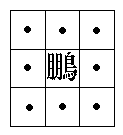
Each player has 1 otori. The otori is the most important piece on the board in the sense that the object of the game is to checkmate the otori. The otori occupies the centre of the first rank, ie: black's otori is on g4, and white's is on a4. The otori may move 1 square in any direction like the king in shogi, that is, one square in a n, n-e, e, s-e, s, s-w, w, nw direction. The otori does not promote.
| The Taka (Falcon) | ||
The Taka and its move look like this:

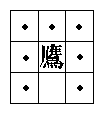
Each player has 1 taka. The taka moves one square in any direction except south, that is, one square in a s-w, w, n-w, n, n-e, e, s-e direction. Black's taka is on f4, and white's is on b4. The taka promotes to an washi:
| The Washi (Eagle) | ||
The washi and its move look like this:

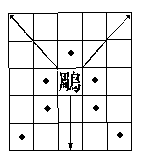
The washi has a complicated move. It may move any number of squares in either forward diagonal direction or directly backwards (ie: n-w, n-e or s directions). Additionally, it may move 1 square n, w or e, or 1 or 2 squares s-e or s-w. Note: The washi may not jump to the second squares in the s-e or s-w directions.
| The Tsuru (Crane) | ||
The tsuru and its move look like this:


The tsuru moves one square in a n-w, n, n-e, s-w, s or s-e direction. Each player has 2 tsuru to start with. Black's tsuru are located at g3 and g5, and white's at a3 and a5.
| The Kiji (Pheasant) | ||
The kiji and its move look like this:

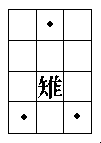
The kiji may move one square in a s-w or s-e direction, or may jump to the second square in a n direction. Each player has 2 kiji to start with. Black's kiji are on g2 and g6, and white's are on a2 and a6.
| The Uzura (Quail) | ||
The uzuru and its move look like this:

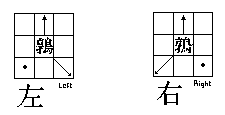
Each player has two uzuru - one each of two different types - a left and right uzuru which are marked on the base as indicated in the diagram. The moves of the left and right uzuru are different as also indicated in the diagram, namely one square s-w and any number of squares in a n or s- direction for a left uzuru, and one square s-e and any number of squares in a n or s-w direction for a right uzuru. Black's left uzuru starts on g7 and the right uzuru on g1. White's left uzuru starts on a1 and the right uzuru on a7.
| The Tsubame (Swallow) | ||
The tsubame and its move look like this:

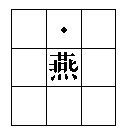
Each player has 8 tsubame to start with The tsubame occupy the third rank on each side plus d3 for black and d5 for white. The tsubame moves one square forward, that is, one square n. When it enters the opponents promotion zone, the tsubame must promote to kari:
| The Kari (Goose) | ||
The kari and its move look like this:

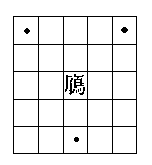
The kari may jump one square in a n-w, n-e or s direction.
| The Initial Setup |



|
|
The diagram below was scanned in (with permission) from the leaflet describing Tori Shogi which is supplied by G F Hodges.
At the start of play, the board is set up like this:

Notation
Tori shogi notation is the same algebraic form as that of shogi.
| The Tori Shogi Rules |


|
|
As Tori Shogi belongs to the family of chess games, the principal rules are the same as shogi unless defined otherwise below. The major difference are the size of the board (7x7) and the available pieces, which are entirely named after birds (that's why it's called Tori Shogi -- Bird Chess).
Additional rules and rules different to normal shogi: